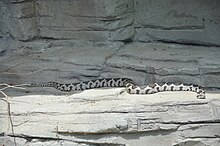Mountain otters
| Mountain otters | ||||||||||||
|---|---|---|---|---|---|---|---|---|---|---|---|---|

Armenian mountain otter ( Montivipera raddei ) |
||||||||||||
| Systematics | ||||||||||||
|
||||||||||||
| Scientific name | ||||||||||||
| Montivipera | ||||||||||||
| Nilson , Tuniyev , Andrén , Orlov , Joger & Herrmann , 1999 |
The mountain otters ( Montivipera ) are a genus of real vipers that contains up to eight species, depending on the source. The best-known mountain otter is the mountain otter of Asia Minor ( Montivipera xanthina ). Like all vipers, mountain otters are poisonous, but the bite is very rarely fatal to humans.
features
The species of mountain otters reach body lengths of 80 to 100 centimeters on average, but especially the Asia Minor mountain otter can also reach lengths of 150 centimeters. The females are usually slightly larger than the males.
distribution
The species of mountain otters live in a relatively narrow distribution area in Asia Minor in the Middle East . The mountain otter of Asia Minor has the largest distribution area from Greece to central Turkey, while the occurrence of all other species is limited to narrow mountain regions in Turkey, Iraq, Iran, Lebanon, Armenia and Azerbaijan, where they are endemic.
As a rule, they live in the dry highlands with little vegetation at altitudes up to over 2000 m with stony and sandy subsoil. The vegetation in these areas consists mainly of grasses and bushes.
Systematics
The taxonomic classification of mountain otters is currently under discussion, which is why there are two alternative generic names in the literature. Traditionally, the mountain otter was assigned to the genus Vipera and formed within this a species complex with a number of other species, which is known as the Vipera xanthina complex. All species within this complex share anatomical features with the mountain otter and live scattered across Asia Minor in higher altitudes of relatively isolated mountain landscapes.
Including the mountain otter, the genus Montivipera now includes the following species:
- M. albicornuta
- M. albizona
- Lebanese mountain otter ( M. bornmuelleri )
- Taurian mountain otter ( M. bulgardaghica )
- Alborz Mountain Otter ( M. latifii )
- Armenian mountain otter ( M. raddei )
- Wagner's mountain otter ( M. wagneri )
- Asian mountain otter ( M. xanthina )
Up until a few years ago, some of these species were considered to be subspecies of the Asian mountain otter, although the species status of V. bulgardaghica or V. albicornuta, for example, is still controversial today.
In 1999, it was proposed that this complex be relocated from the genus Vipera under the new genus name Montivipera , although this was only able to establish itself to a limited extent in the literature. In 2005 Joger and Nilson led the mountain otters under the species name Montivipera xanthina and the database The Reptile Database established the genus Montivipera as a separate genus and separated it from Vipera . Mallow et al. 2003 leads this and the other species, however, still under the established names within the genus Vipera and assign them to the subgenus Montivipera .
By Lenk et al. In 2001 the monophyly of the Montivipera species was confirmed as a separate taxon via immunological studies. According to the results, however, these represent the sister group of two great viper species ( Macrophia ) within a complex of Daboia , Macroocket and the Montivipera species, whereby the genus Vipera with the inclusion of the subgenus Montivipera is no longer a natural relatives group with all descendants of a parent species (monophyletic Group) is durable and to be regarded as paraphyletic.
|
|
|
||||||||||||||||||||||||
|
|
This view is confirmed by Garrigues et al. 2004, in which the vipers form a European section from different Vipera species as well as an oriental section from the named genera Daboia and Macroypena and the Montivipera species. Today all species of the Xanthina complex of the genus Montivipera are added accordingly .
swell
Sources cited
Most of the information in this article has been taken from the sources given under literature; the following sources are also cited:
- ^ G. Nilson, C. Andrés: The mountain vipers of the middle east - The Vipera xanthina complex (Reptilia, Viperidae). Bonn Zoological Monographs No. 20, Bonn 1986; ISBN 3-925382-20-8
- ↑ All information from Mallows et al. 2003
- ↑ Montivipera in The Reptile Database ; Retrieved January 6, 2011.
- ↑ Lenk, P., S. Kalayabina, M. Wink & U. Joger: Evolutionary relationships among the true vipers (Reptilia: Viperidae) inferred from mitochondrial DNA sequences. Molecular Phylogenetics and Evolution 19; 2001: 94-104. ( Full text PDF )
- ↑ Thomas Garrigues, Catherine Dauga, Elisabeth Ferquel, Valérie Choumet and Anna-Bella Failloux: Molecular phylogeny of Vipera Laurenti, 1768 and the related genera Macroypena (Reuss, 1927) and Daboia (Gray, 1842), with comments about neurotoxic Vipera aspis aspis populations. Molecular Phylogenetics and Evolution 35 (1), 2005; Pp. 35-47.
- ↑ Nikolaus Stümpel, Ulrich Joger: Recent advances in phylogeny and taxonomy of Near and Middle Eastern Vipers - an update. ZooKeys 31 (2009), Special Issue. ( doi : 10.3897 / zookeys.31.261 ).
literature
- David Mallow, David Ludwig, Göran Nilson: True Vipers. Natural History and Toxinology of Old World Vipers. Krieger Publishing Company Malabar, Florida, 2003; Pages 280-299. ISBN 0-89464-877-2

